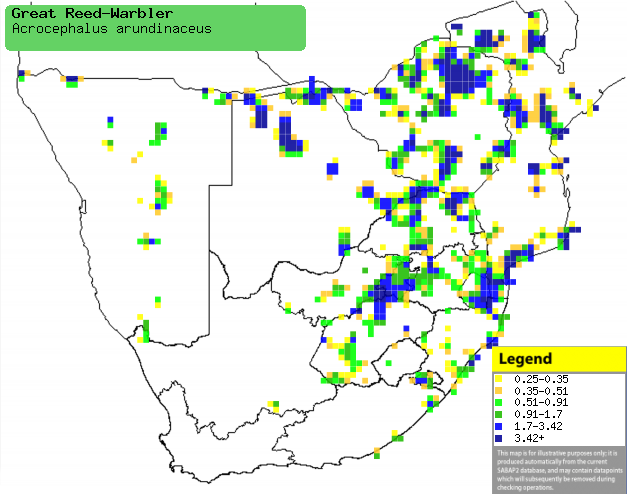|
Acrocephalus arundinaceus
(Great reed-warbler)
Grootrietsanger [Afrikaans]; Niini (generic term for
warblers and eremomelas) [Kwangali]; Soamahlaka-kholo [South Sotho]; Timba
(generic name for cisticolas and warblers) [Shona]; Grote karekiet
[Dutch]; Rousserolle turdoïde [French]; Drosselrohrsänger [German];
Rouxinol-grande-dos-caniços [Portuguese]
Life
> Eukaryotes >
Opisthokonta
> Metazoa (animals) >
Bilateria >
Deuterostomia > Chordata >
Craniata > Vertebrata (vertebrates) > Gnathostomata (jawed
vertebrates) > Teleostomi (teleost fish) > Osteichthyes (bony fish) > Class:
Sarcopterygii (lobe-finned
fish) > Stegocephalia (terrestrial
vertebrates) > Tetrapoda
(four-legged vertebrates) > Reptiliomorpha > Amniota >
Reptilia (reptiles) >
Romeriida > Diapsida > Archosauromorpha > Archosauria >
Dinosauria
(dinosaurs) > Saurischia > Theropoda (bipedal predatory dinosaurs) >
Coelurosauria > Maniraptora > Aves
(birds) > Order: Passeriformes
> Family: Sylviidae > Genus: Acrocephalus
 |
|
|
Great reed-warbler, Portugal. [photo
Jose Viana
©] |
|
Distribution and habitat
It breeds across much of Eurasia and North Africa, flying
south to sub-Saharan Africa in the non-breeding season. In southern Africa it
not only occurs reedbeds but also in other vegetation sometimes far from water,
such as dense bush, gardens, sugar cane plantations. In arid areas it tends to
only occupy wetland reedbeds, as the habitat away from the water is often to
dry.
|
 |
|
Distribution of Great reed-warbler in southern
Africa, based on statistical smoothing of the records from first SA Bird
Atlas Project (©
Animal Demography unit, University of
Cape Town; smoothing by Birgit Erni and Francesca Little). Colours range
from dark blue (most common) through to yellow (least common).
See here for the latest distribution
from the SABAP2. |
Movements and migrations
It leaves its breeding grounds around
August-September, flying directly to sub-Saharan Africa. Most
individuals arrive in southern Africa from November through to
December, latecomers have been recorded in January. It often stays
in the same area in consecutive non-breeding seasons, typically
leaving this region from late February-March.
Food
It eats a variety of insects, doing most of its foraging
near the ground, plucking prey from the ground and surrounding foliage. The following food items have been recorded
in its diet in Zambia:
- Invertebrates
- Small frogs
Threats
Not threatened.
References
-
Hockey PAR, Dean WRJ and Ryan PG 2005. Roberts
- Birds of southern Africa, VIIth ed. The Trustees of the John Voelcker
Bird Book Fund, Cape Town.
-
Harrison, J.A., Allan, D.G., Underhill, L.G., Herremans, M.,
Tree. A.J., Parker, V. & Brown, C.J. (eds). 1997. The atlas of southern
African birds. Vol. 2: Passerines. BirdLife South Africa, Johannesburg.
|
